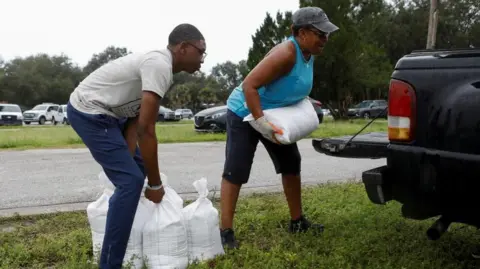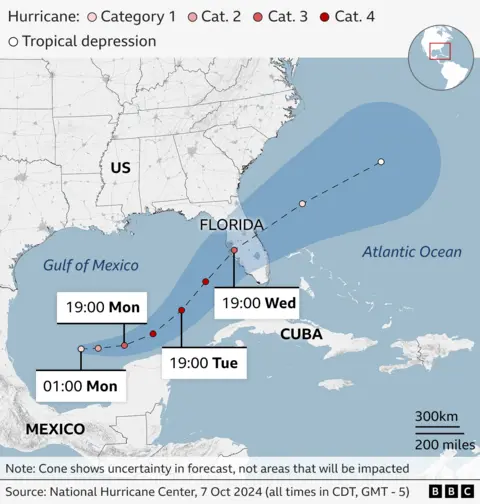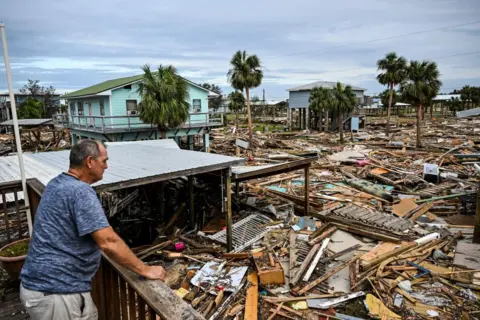
 Reuters
Reuters
Preparations for Milton are under way, with residents filling sandbags ahead of the storm
Floridians have been told to prepare for the US state's largest evacuation effort for years as a new hurricane heads for the Gulf Coast, which is still reeling from another historic storm.
Hurricane Milton, off the Mexican coast, has been strengthening and could threaten lives when it reaches the state's west coast in the middle of the week, the National Hurricane Centre (NHC) says.
It comes just 10 days after Storm Helene - the deadliest mainland storm since Katrina in 2005 - tore through the US south-east, killing at least 225 people. Hundreds of others are still missing.
At least 14 of those deaths were in Florida, where 51 of 67 counties are now under emergency warnings as Milton approaches.
Milton intensified from a tropical storm to a hurricane on Sunday, and by Monday morning was sustaining wind speeds of nearly 100mph (155km/h), the NHC said.
It is expected to strengthen further, becoming a major hurricane, before making landfall around Tampa Bay on Wednesday.
Milton is then forecast to continue tracking north-east, cutting across the Florida peninsula as it heads for the Atlantic Ocean.
The NHC has warned of continued high winds, heavy rainfall causing flash flooding, and a storm surge caused by rising water moving inland from the Gulf Coast.
Rainfall totals could reach localised highs of 15in (38cm).
The NHC's dire warnings have been matched by state officials.
Floridians have been told by the state's emergency management division head, Kevin Guthrie, to prepare for the "largest evacuation that we have seen most likely since 2017, Hurricane Irma". Dozens of people were killed by Irma that year.
Governor Ron DeSantis, who issued the state's 51 emergency warnings, said preparations were under way to restore power and clear roads, but that people should expect more disruption when Milton hit.
He urged Floridians to have a "preparedness plan", warning of both mandatory and voluntary evacuations. He could not foresee "any scenario where we don't have major impacts", he explained.
Many evacuations are expected in Pinellas County, where at least a dozen people were killed by Helene.


The approach of the new hurricane comes as the US government warns that clean-up efforts could take years after Hurricane Helene.
Hundreds of roads in affected areas remain closed, hampering efforts to send aid to hard-hit communities.
It made landfall in late September as a category-four hurricane - damaging structures, causing flash flooding and knocking out power to millions of homes.
As well as in Florida, deaths were recorded in Georgia, South Carolina, Tennessee and Virginia - and the worst-hit state, North Carolina.
President Joe Biden has ordered another 500 soldiers to be deployed to North Carolina. The troops - who now number 1,500 in all - will work with thousands of government relief workers and National Guard.
Biden has so far approved nearly $140m (£107m) in federal assistance. The use of the money has become the subject of false claims by Donald Trump, the Republican candidate for next month's presidential election, who said relief money had been spent on migrants.
Trump has been accused of "dangerous" misinformation by the head of the US disaster relief agency.

 CHANDAN KHANNA/AFP
CHANDAN KHANNA/AFP
Hurricane Helene made landfall in Horseshoe Beach, Florida, on 26 September



 1 month ago
12
1 month ago
12










 English (US) ·
English (US) ·